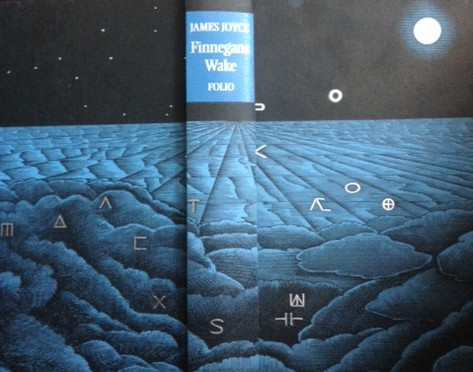Inspiring Older Readers
 posted on 30 Apr 2019
posted on 30 Apr 2019
Finnegans Wake by James Joyce, illustrated by John Vernon Lord
This Folio Society gem both precedes and is a companion piece to Joyce’s Ulysses that was also illustrated in a special edition by John Vernon Lord. My review of Lord’s Ulysses claimed that the book should be considered a serious and major work of art and I could say exactly the same of this edition of Finnegans Wake. However, put the two volumes together and you have a really extraordinary total work of the imagination in which the author and illustrator are working to their maximum potential.
I honestly thought that finding a way of illustrating a book like Ulysses was difficult enough without falling back on what would be inappropriately literal or realist images but doing the same for Finnegans Wake struck me as a challenge too far. Famously, Joyce by the time he was writing FW had abandoned ideas of traditional notions of structure and language and set about constructing something that took the idea of a book to new, previously unimagined places - allowing the author to investigate consciousness and its meaning. I have never been able to read Finnegans Wake as a whole work – I have sampled chunks of it which were challenging enough but try as I might I have never been able to get beyond that.
It’s fascinating to see the way Lord approached his task. This, from the introduction, is, I think, a revealing way of explaining how he went about the job:
“Reading such a text as Joyce’s, and interpreting it, is a greater challenge than for most books. After all each word is “as cunningly hidden in its maze of confused drapery as a field mouse in a nest of coloured ribbons.” Sometimes I felt like Alice in Through the Looking-Glass when she first read “Jabberwocky.” She commented, “It seems very pretty… but it’s rather hard to understand… Somehow it seems to fill my head with ideas — only I don’t exactly know what they are!” Finnegans Wake is a book that has to be experienced rather than fully understood.”
I think this demonstrates that Lord really did get into the very fabric of the book and that being prepared to let go of ideas of traditional narrative and structure was essential if he was going to produce meaningful illustration. I would struggle to do justice to Lord’s interpretations if I tried to describe them but fortunately for me and you when the book was originally published in 2014, The Guardian website put together a slide show that includes captions written by the artist explaining how he interpreted the various scenes and passages of Finnegans Wake he chose to depict.
The bad news is that the book is currently out of print and there was only a limited number printed in the first edition. This makes the book extraordinarily elusive at the moment and I really struggled to get my hands on a copy. I contacted the Folio Society itself and they confirmed the book is out of print and, as I write, there is no date in the diary for a reprint. They helpfully gave me the names and contact details of specialist second hand dealers specialising in Folio Society editions and in all cases they couldn't point me to an available copy. Sheer bloody-minded persistence and my love of a book quest enabled me to eventually came upon one on a dusty neglected shelf in Hay-On-Wye and I paid a bargain £90 for it – a fraction of what I think its market value to be.
So, enjoy the illustrations in The Guardian slide show and the modest examples I have taken from my edition at the bottom of this page and if you do see a copy you can afford, I'd strongly advise you to snap it up before someone else beats you to it.
Terry Potter
April 2019






